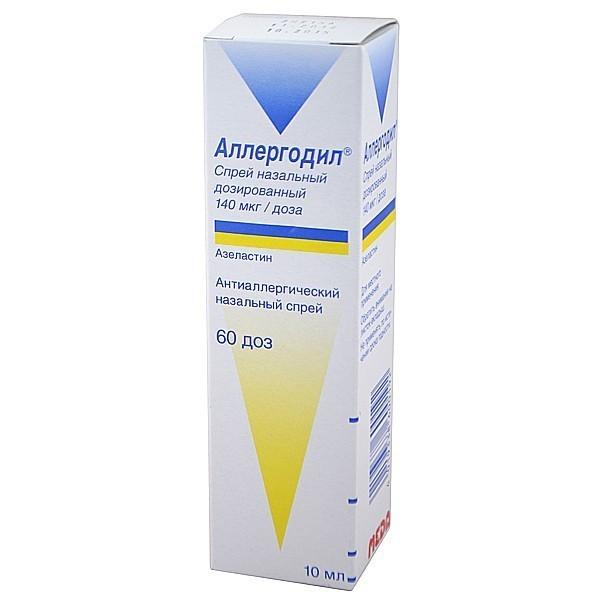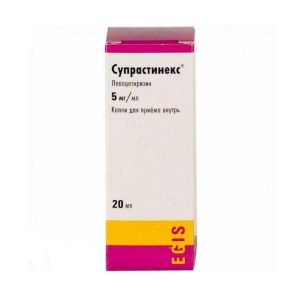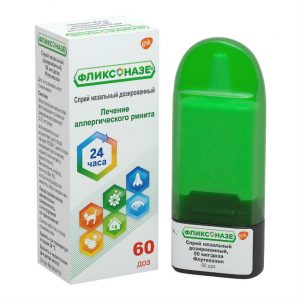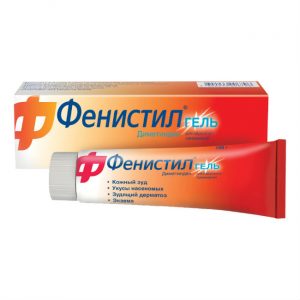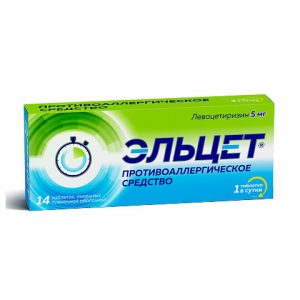Description
Latin name
Allergodil
Release form
Nasal spray dosage 140 mcg / dose.
10 ml of solution in a brown glass bottle with a screw-on dispenser.
1 bottle, together with instructions for use, is placed in a cardboard box.
Pharmacological action
Pharmacotherapeutic group: antiallergic agent – H1 histamine receptor blocker.
Pharmacological action:
Azelastine, a phthalazinone derivative, is a long-acting antiallergic. Being a selective H1-histamine blocker, it has an antihistamine, anti-allergic and membrane stabilizing effect, reduces capillary permeability and exudation, stabilizes mast cell membranes and prevents the release of biologically active substances (histamine, serotonin, leukotrienes, platelet activating factor, etc.), which cause bronchospasm and contribute to the development of early and late stages of allergic reactions and inflammation. When applied topically, the systemic effect is negligible.
Intranasal administration reduces itching and nasal congestion, sneezing, and rhinorrhea. The weakening of symptoms of allergic rhinitis is noted starting from 15 minutes after application and lasts up to 12 hours or more.
There is no clinically significant effect on the QT (QTc) interval even with prolonged use of high doses of azelastine.
Pharmacokinetics:
Bioavailability after intranasal administration is about 40%.
The maximum concentration (Cmax) in the blood after intranasal administration is achieved after 2-3 hours. When administered intranasally at a daily dose of 0.56 mg of azelastine hydrochloride (one injection in each nasal passage twice a day), the average equilibrium plasma concentration of azelastine hydrochloride in plasma 2 hours after administration is 0.65 ng / ml.
Doubling the total daily dose to 1.12 mg (two injections in each nasal passage twice a day) leads to a stable average plasma concentration of azelastine equal to 1.09 ng / ml.
However, despite the relatively high absorption in patients, systemic exposure after intranasal administration is approximately 8 times lower than after oral administration of a daily dose of 4.4 mg azelastine hydrochloride, which is a therapeutic oral dose for the treatment of allergic rhinitis.
Intranasal administration in patients with allergic rhinitis causes an increase in plasma azelastine levels compared with healthy subjects.
Other pharmacokinetic data studied when administered orally.
Communication with blood proteins 80-90%.
Metabolized in the liver by oxidation using the cytochrome P450 system to form the active metabolite of desmethylazelastine. It is excreted mainly by the kidneys in the form of inactive metabolites.
The half-life (T1 / 2) of azelastine is about 20 hours, its active metabolite desmethylazelastine is about 45 hours.
Contraindications
Hypersensitivity to azelastine and / or other components of the drug
For allergic rhinitis and rhinoconjunctivitis – children under 6 years of age with vasomotor rhinitis – children under 12 years of age.
Use during pregnancy and lactation
When testing doses many times exceeding the therapeutic range, no evidence of teratogenic effects was obtained in animals, but since there is no experience with azelastine in pregnant and lactating women, the use of azelastine nasal spray during pregnancy, as well as during lactation.
Special instructions
Impact on the ability to drive vehicles and work with complex mechanisms.
In rare cases, fatigue, fatigue, dizziness, or weakness, which may be a consequence of the disease itself, can develop when using azelastine nasal spray. In these cases, driving a car and working with complex machinery should be avoided.
Special instructions
In some cases, the use of nasal spray reveals fatigue, varying severity and weakness, which can also be caused by the underlying disease. In these cases, it is not recommended to drive a car and work with dangerous machinery. Alcohol consumption can enhance these effects
Ingredients
1 dose contains: Active substance: azelastine hydrochloride 0.140 mg
Excipients: hypromellose 0.140 mg disodium edetate 0.761 mg sodium hydrogen phosphate 0.30 mg citric acid 0.30 mg sodium hydroxide 0.30 mg citric acid 0.30 mg citric acid 0.30 mg citric acid 0.30 mg citric acid 0.30 mg citric acid 0.30 mg citric acid , purified water 138.419 mg.
Dosage and Administration
Intranasally.
Allergic rhinitis and rhinoconjunctivitis: Unless otherwise recommended for adults and children 6 years of age and older, one dose (140 mcg / 0.14 ml) in each nasal passage twice daily in the morning and evening. If necessary, adults and children over 12 years old – two doses (280 mcg / 0.28 ml) in each nasal passage twice a day in the morning and evening. Allergodil is used until symptoms cease and is suitable for prolonged use, but not more than 6 months of continuous treatment.
Vasomotor rhinitis: Adults and children over 12 years of age – two doses (280 mcg / 0.28 ml) in each nasal passage twice a day in the morning and evening. Allergodil is used until symptoms stop and is suitable for long-term use, but not more than 8 weeks of continuous treatment.
The volume of one injection (single dose) is 0.14 ml and contains 140 micrograms of active substance.
Application procedure: 1. Remove the protective cap
2. Prior to first use, press the spray gun 2 3 times.
3. Depending on the prescribed dose, inject once or twice into each nasal passage, keeping your head straight.
4. Replace the protective cap.
Side effects
The frequency of side effects is defined as follows: Very often:> 1/10
Frequently: <1/10> 1/100
Infrequently: <1/100> 1/1000
Rarely: <1/1000> 1/10000
Very rare: <1/10000. Often – as a result of an incorrect method of administration, when the head is thrown back, a bitter taste in the mouth may appear, which in rare cases can cause nausea. Infrequently – mild, transient irritation of the inflamed nasal mucosa, manifested by burning, itching, sneezing, and, in rare cases, nosebleeds. Very rarely – allergic reactions (rash, pruritus, urticaria), weakness, dizziness (may be caused by the disease itself). Drug Interactions With intranasal administration of azelastine, no clinically significant interaction with other drugs has been identified. Overdose There are currently no known cases of overdose with intranasal use. Storage Conditions At 8 – 25 ° C. Keep out of reach of children Dosage form nasal drops Active ingredient Azelastine Conditions of release from pharmacies Without prescription dosage form nasal spray Appointment Appointment Children older than 6 years, Adult Meda Farma GmbH and Ko.KG, Switzerland
